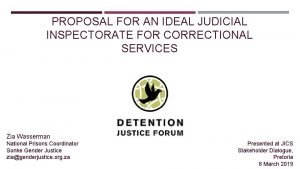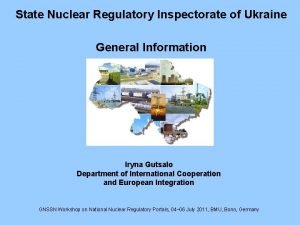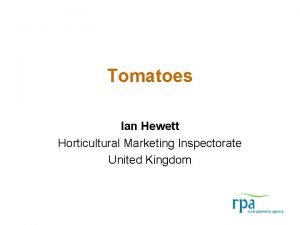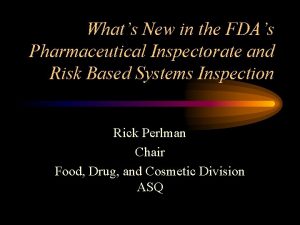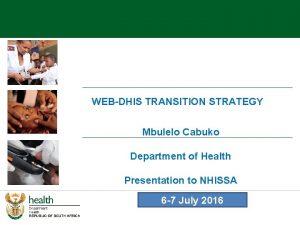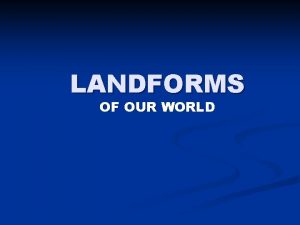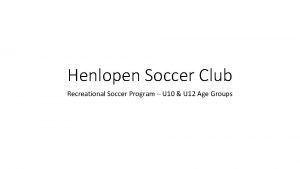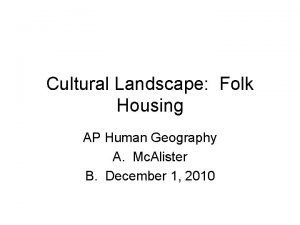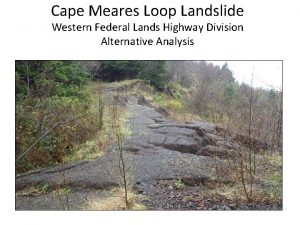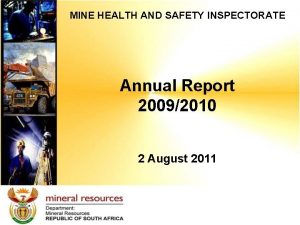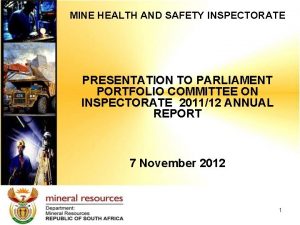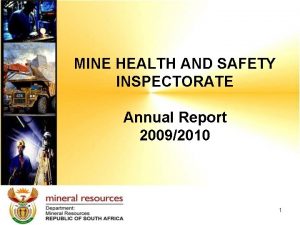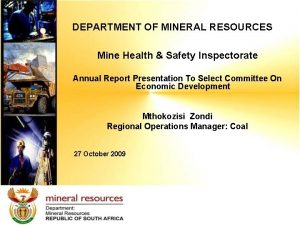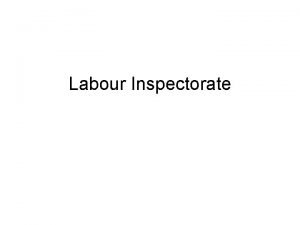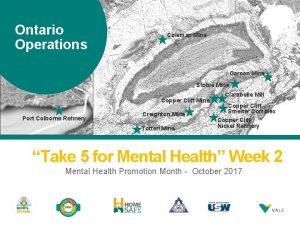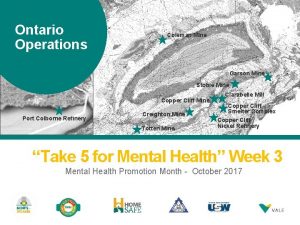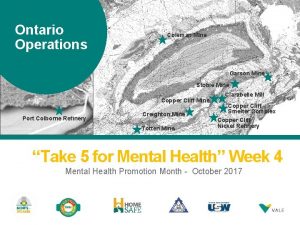Mine Health Safety Inspectorate Northren Cape Region May














- Slides: 14

Mine Health & Safety Inspectorate Northren Cape Region – May 2014 MH Sease - IOM

Occupational Hygiene V/S Environmental Engineering Purpose Occupational Hygiene is about Measuring of levels of exposure to hazards and the Establishment of an Occupational Hygiene measurement system that is 1. Appropriate considering hazards 2. Provides accurate and reliable information to the employer for proper intervention 3. Ensures correct record keeping and that can be used by Medical Practitioner Environmental engineering is about using hygiene records to design systems that eliminates or reduces exposure of employees to the hazards by engineering or administration methods.

Main Responsibilities of a Hygienist or Environmental Engineer at mines • Ventilation – Removal or Dilution of Airborne pollutants and supply of Oxygen • Noise – Prevention of Hearing loss • Heat – Prevention of Heat related incidents • Illumination – Improvement of vision • Ergonomics – Body stresses related injuries and delayed health problems • Dust – Prevention of Pneumoconiosis (Lung Diseases • Hygiene – Chemicals/Germs/disease free environment/fatique • Emergency preparedness and response

Legal Appointments • Section 12. (1) Part time or Full time Occupational Hygienist or Environmental Engineer • Qualifications – Certificate in Mine Environmental Control or – Intermediate Certificate in Mine environmental Control coupled with being certified as and Occupational Hygienist by the South African institute for Occupational Hygiene.

Governing MHSI Regulations • Chapter 5 (Fires and Explosions) – Prevention and suppression systems for coal dust and flammable gas – Prevention, detect ion and combating the start and spread of mine fires – Transportation, storage, deposit and disposal of flammable liquids, gas and materials • Chapter 17 – Emergency/Evacuation plans

Governing MHSI Regulations Continue • Chapter 9 (Environmental Engineering and Occupational Hygiene) – – – Safe use of compressed air Efficient Early warning devices Ventilation control devices safety Ceased working places safety Hygiene • • • Establishment of hygiene measurement system( Airborne pollutants, gases and vapors, thermal stress and noise Portable and palatable water Ablution and change house facilities. Clean working clothes Correct respiratory equipment Proper Illumination

Governing MHSI Regulations Continue • Chapter 16 (Rescue & First Aid & Emergency preparedness & response – Self Contained Self rescuers • • Sole allocation Maintenance Monitoring programme Record Keeping – Mine First Aid/Evacuation/Rescue Teams readily available

Governing MHSI Regulations Continue • Chapter 22(qualifications, skills and affiliations) – 22. 15(5)(a) for chapter 5 – 22. 15(9)(a) for chapter 9 – 22. 15(16)(a) for chapter 16

Challenges Facing the Mines • Inadequate systems results in: – Mental Stresses – Physical Stresses – Psychological Stresses – Poor Health – Accidents What most mines do not realize is that poor environmental conditions contributes a lot to poor productivity as this also affect machinery and Equipment as well as working place safety.

Linking of Medical records • The purpose is to assist the Medical practitioner to conduct risk analysis and to ensure that proper diagnosed is done prior or after exposure of individuals. The following is important: – Health hazards to be communicated to the Occupational Medical Practitioner – The aim is to prevent, detect or properly treat occupational diseases.

Challenges • Part Time Occupational Hygienist referred to as Consultants(presence and service) Poor risk assesments • Health issues are delayed and not quickly diagnosed like safety hence don’t get correct attention. • Dedicated, Committed, Determined, Unsupervised, Assertive Qualified and skilled Hygienist? • Poor empowerment of Hygienists and support at mines. • Small mines appointing illegal immigrants and high turnover and no surveillance or hygiene measurements • Mines (especially small ones)knowledge of the service requirements from Hygienists they appoint • Submission of correct reports to the office • Data capturing and analysis • Reliability of reports and records submitted.

Main Deviations • Poor ventilation conditions. – – – – – Fan/Column distance to face Ventilation curtains distance to face High temperatures Blasting schedule signed by Hygienist Evacuation plans Emergency plans Use of GDI’s and how to measure airflow Lamp room systems Codes of practices applicability • Change houses and Ablution facilities

Questions

ACKNOWLEDGEMENT • Mr. E. Babuseng
 That moment she was mine mine fair
That moment she was mine mine fair Judicial inspectorate for correctional services
Judicial inspectorate for correctional services Factory inspectorate
Factory inspectorate State nuclear regulatory inspectorate
State nuclear regulatory inspectorate Horticultural marketing inspectorate
Horticultural marketing inspectorate Timis county school inspectorate
Timis county school inspectorate Pharmaceutical inspectorate
Pharmaceutical inspectorate Intermuscular spaces
Intermuscular spaces Active region and saturation region
Active region and saturation region Webdhis eastern cape
Webdhis eastern cape South carolina lighthouses map
South carolina lighthouses map Tundra landforms
Tundra landforms Henlopen soccer club
Henlopen soccer club New england housing styles ap human geography
New england housing styles ap human geography Cape meares loop
Cape meares loop

